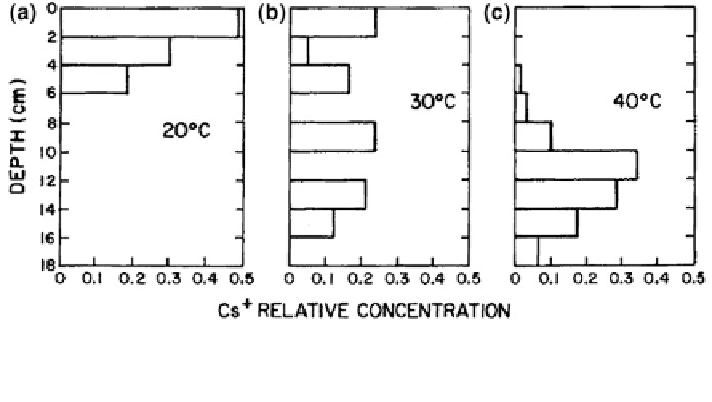Geoscience Reference
In-Depth Information
Simulated Chernobyl Cs
+
distribution in the soil ecosystem in soil columns when the
Fig. 8.43
microbial
decomposition
of
the
organic
material
is
enhanced
by
an
increase
in
ambient
temperature a 20 C, b 30 C, c 40 C (Tengen et al.
1991
)
without excessive pressure buildup, contrary to NAPL injection, which requires
introduction to the subsurface by high pressure.
Subsurface organisms and organic residues also may affect vertical migration of
contaminants. In a laboratory experiment by Tengen et al. (
1991
), the influence of
microbial activity on the migration of Cs
+
and the effect of OM residue on Cs
+
retention were illustrated. These experiments were performed to understand the
consequences of the Chernobyl accident in 1986. Figure
8.43
shows the distri-
bution of Cs
+
in soil columns leached at temperatures of 20, 30, and 40 C. Based
on these results, Tengen et al. (
1991
) note the dominant role of the turnover of
nondecomposed soil OM on Cs
+
retention in the subsurface: After deposition on
land surface, the contaminant is fixed mainly by nondecomposed organic material
and subsequently redistributed with depth as a result of microbial decomposition.
This process is induced by an increase in temperature and the dissolution of
organic C compounds in the infiltrating water. While the organic material is not
decomposed, the Cs
+
is retained in the top layer of the subsurface. By decom-
position of OM, the Cs
+
is complexed and transported to deeper layers.
The residual content of immiscible liquids can be defined by the amount of
NAPL remaining in the subsurface when pore geometry permits NAPL flow
greater than the retention capacity. In an outdoor pilot experiment, Fine and Yaron
(
1993
) studied the effect of soil constituents and soil moisture contents on the
retention of kerosene in the subsurface. This retention is termed the kerosene
residual content (KRC). Ten soils were studied, with a broad spectrum of clay and
OM contents, together with four soil moisture contents corresponding to oven-
dried, air-dried, 33 kPa tension and 199 kPa tension. The KRC of the soils, studied
as a function of clay content and moisture content, is presented in Fig.
8.44
. The
KRC of oven-dried soils ranged from 3.5 to 18.1 mL/100 g. It is affected by the

